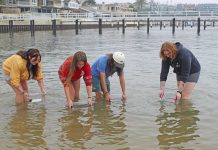The California Coastal Commission agreed last week to allow additional digging and archaeological testing at the controversial proposed mixed-use project, Banning Ranch, but only with more inclusive Native American monitoring, better communication, and deeper test pits.
An amended staff report for an administrative permit for archaeological investigations on the site was unanimously accepted after some discussion during the CCC meeting on Aug. 11.
An important change in the amended staff report states that representatives from all nine distinct tribal groups among the Gabrieleño-Tongva and Juaneño-Coachmen (as identified on the Native American Heritage Commission’s most current California Tribal Consultation List) are invited to be on site at all times during the testing.
Other amendments include deeper soil test pits, submittal of the results of the ground penetrating radar and a soil testing plan subject to review by the interested tribal groups, and confirming that the contact information for the tribes is accurate and that all are included in the communications.
The applicant, Newport Banning Ranch, LLC, agreed to the amendments and Mike Mohler confirmed the developer’s willingness on all points.
“We’re happy to do it, we are going to do it,” Mohler said. “We’re ready to go.”
The site was added to the sacred lands inventory by the Native American Heritage Commission in February due to its cultural significance, explained CCC South Coast District (Orange County) Deputy Director Sherilyn Sarb.
The sites that are on the sacred list are being preserved as part of the plan, Mohler said.
The testing is being done in order to rule out, to the furthest extent possible, any potential significant cultural resources, such as burials, within the proposed development footprint, Sarb added.
It’s likely that other sacred items or remains will be uncovered, so testing is critical, noted Angela Mooney D’Arcy, who spoke representing the Juaneno Band of Mission Indians, Acjachemen Nation, and as executive director and founder of Sacred Places Institute for Indigenous Peoples.
“Folks are supportive of additional archaeological testing because it is a sacred site,” Mooney D’Arcy said.
Human remains have been found on the site in the past, reported Steve Ray, Executive Director of the Banning Ranch Conservancy, a strong opponent to the proposed project and an advocate for preserving the site as permanent public open space.
“We’re concerned that there may not be enough exploration, enough activity, to identify the possibilities for (more) human remains,” Ray said.
The ground penetrating radar that NBR has been using does not pick up on human remains, he explained.
“As a result, it’s possible that a lot may be missed,” Ray said.
Mooney D’Arcy also brought up some concerns about the Native American monitoring.
“Unfortunately, from our perspective, the developer has been less than above board, in terms of what information has been shared with which particular groups,” Mooney D’Arcy said. “There is a lot of selectivity, in terms of who information is being shared with.”
Given that observation, the sensitivity of the site, and the high publicity around it, among other issues, they believe that there should be a monitor from each of the nine tribes at all times.
“Unfortunately, that’s the only way that we see at this point where we can actually guarantee transparency,” she said.
She also commented that the communication should be better. Some of the leaders were not noticed of the proposal for the permit, she said. All groups should receive all the available information as expeditiously as possible, Mooney D’Arcy suggested.
Commissioners were also concerned about making sure all tribes were included in the communication and that the contact information was accurate.
It will be cleared up before any further testing occurs, Sarb said.
“I don’t want a notification issue to be the issue that drags this down,” said Commissioner Wendy Mitchell.
There was also some concern about whether or not the testing can be done in time for the next meeting. Commissioners are scheduled to hear the actual project, consisting of residential, hotel, retail and open space on 401 acres, in September.
“When we first heard about this we were seriously concerned about the effort,” Ray said. “We still have some serious concerns about whether this project should go forward as it is and its impact on the entire Banning Ranch project hearing for next month.”
Testing needs to be completed in time to include results on the staff report, Ray pointed out.
“I’m concerned that there’s not enough time here for this activity to be done and to be accomplished in a complete and thorough way,” he said.
Ray suggested that the applicant withdraw their application and re-submit so that it can be re-scheduled for an appropriate hearing date.
“The ultimate goal for the site is preservation of all the cultural resources in situ on the site,” Sarb said. “But we want to be as sure as possible that there is nothing in the pockets of the site where development may be allowed. This soil testing is the minimum necessary to do that, and it may not achieve that goal in the time that we have.”
CCC is scheduled to meet Sept. 7-9 in the Newport Beach City Council chambers at the civic center. South County and Newport Beach items are typically heard on the second day. For more information, visit coastal.ca.gov.




